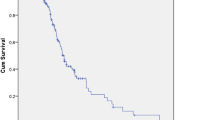Abstract
In the Three-year Report of the Population-Based Cancer Registries: 2012–2014 published by the Indian Council of Medical Research (ICMR 2016) [11], the incidence of nasopharyngeal carcinoma (NPC) in Nagaland has been ranked as the highest in the country and the second-highest globally next to China. With the paucity of literature and very few studies done on the high incidence of NPC among the Nagas in Nagaland, the present study was undertaken to understand and examine the experiences and perceptions of patients diagnosed with NPC and efforts were made to draw on their experiences with cancer care treatment through the thematic analysis of the ten in-depth interviews conducted. The patient’s experiences with anxiety, fear, and distress due to NPC, its impact on the reconstruction of self, the coping mechanisms they develop in the form of resilience, personal attributes of hope and optimism, and the impact of religion and prayers in helping them deal with their disease are discussed in the paper.
Similar content being viewed by others
Notes
The term “Nagas” is used to refer to a group of people who live mostly in the mountainous region which was called the Naga Hills during the British Colonial period. In India, they live in the states of Arunachal Pradesh, Assam, Manipur, and Nagaland which all lie in the northeastern part of the country [20].
Nagamese is a common language spoken by all the people in Nagaland. It is also known as the contact language or bazaar (market) language in Nagaland because this language emerged during the business transactions with the non-Naga traders and service providers who came to the Naga Hills with the arrival of the British forces. It is a mixture of mostly Hindi language and Assamese language [20].
References
Braun V, Clarke V (2006) Using thematic analysis in psychology. Qualitative Research in Psychology 3:77–101. https://doi.org/10.1191/1478088706qp063oa
Busson P (2013) Nasopharyngeal carcinoma: keys for translational medicine and biology. Springer-Verlag https://www.springer.com/us/book/9781461459460
Decker CL, Haase JE, Bell CJ (2007) Uncertainty in adolescents and young adults with cancer. Oncology Nursing Forum 34(3):681–688. https://doi.org/10.1188/07.ONF.681-688
De-Thé G, Itō Y (1978) Nasopharyngeal carcinoma: etiology and control. International Agency for Research on Cancer, Lyon, France
Douglas T (2017). From traditional tools and local spirits to digital tools and new interpretations: reflections on artistic practice in Nagaland. The South Asianist, 5(1). Retrieved from http://www.southasianist.ed.ac.uk/article/view/1857
Haleshappa RA, Thanky AH, Kuntegowdanahalli L, Kanakasetty GB, Dasappa L, Jacob L (2017) Epidemiology and outcomes of nasopharyngeal carcinoma: experience from a regional cancer center in Southern India. South Asian Journal of Cancer 6(3):122–124. https://doi.org/10.4103/2278-330X.214578
Hewitt M, Greenfield S, Stovall E (2006) From cancer patient to cancer survivor: lost in transition. The National Academies Press, Washington, D.C Retrieved from http://georgiacore.org/articleImages/articlePDF_396.pdf
ICMR (2003) Epidemiological and etiological factors associated with nasopharyngeal carcinoma 33(9):9 http://icmr.nic.in/BUSEPT03.pdf
Imchen T (2017) Accessibility to healthcare services and continuity of care for nasopharyngeal carcinoma (NPC) patients in Nagaland. Jawaharlal Nehru University, New Delhi
Indian Council of Medical Research. (2014). Disease-specific documents for XII Plan. Cancer research. High power committee to evaluate the performance of ICMR, 2012-2013. Division of Publication and Information on behalf of the secretary DHR & DG, ICMR, Ministry of Health and Family Welfare. icmr.nic.in/Publications/hpc/PDF/Annexure%2018.pdf
Indian Council of Medical Research. (2016). Three year report of PBCR 2012-2014. Bengaluru, India. Retrieved from http://ncrpindia.org/ALL_NCRP_REPORTS/PBCR_REPORT_2012_2014/index.htm
Jacobs J (2012) The Nagas: hill peoples of Northeast India: society, culture and the colonial encounter. Thames & Hudson Ltd, New York, N.Y
Kataki AC, Simons MJ, Das AK, Sharma K, Mehra NK (2011) Nasopharyngeal carcinoma in the Northeastern states of India. Chinese Journal of Cancer 30(2):106–113
Krishna SM, James S, Kattoor J, Balaram P (2004) Serum EBV DNA as a biomarker in primary nasopharyngeal carcinoma of Indian origin. Japanese Journal of Clinical Oncology 34(6):307–311. https://doi.org/10.1093/jjco/hyh055
Lee Y-L, Gau B-S, Hsu W-M, Chang H-H (2009) A model linking uncertainty, post-traumatic stress, and health behaviors in childhood cancer survivors. Oncology Nursing Forum 36(1):E20–E30. https://doi.org/10.1188/09.ONF.E20-E30
Levine EG, Aviv C, Yoo G, Ewing C, Au A (2009) The benefits of prayer on mood and well-being of breast cancer survivors. Supportive Care in Cancer 17(3):295–306. https://doi.org/10.1007/s00520-008-0482-5
McCaffrey AM, Eisenberg DM, Legedza ATR, Davis RB, Phillips RS (2004) Prayer for health concerns: results of a national survey on prevalence and patterns of use. Archives of Internal Medicine 164(8):858–862. https://doi.org/10.1001/archinte.164.8.858
Molina Y, Yi JC, Martinez-Gutierrez J, Reding KW, Yi-Frazier JP, Rosenberg, A. R. (2014) Resilience among patients across the cancer continuum: diverse perspectives. Clinical Journal of Oncology Nursing 18(1):93–101. https://doi.org/10.1188/14.CJON.93-101
Rowland JH, Baker F (2005) Introduction: resilience of cancer survivors across the lifespan. Cancer 104(11 Suppl):2543–2548. https://doi.org/10.1002/cncr.21487
Thong T (2016). Colonization, proselytization, and identity: the Nagas and westernization in Northeast India (1st ed. 2016 edition). Palgrave Macmillan
Author information
Authors and Affiliations
Corresponding author
Ethics declarations
Ethics approval
Ethical approval from the Centre of Social Medicine and Community Health, Jawaharlal Nehru University New Delhi on January 5, 2017.
Consent to participate (include appropriate statements)
Consent was taken.
Consent for publication (include appropriate statements)
Consent was taken.
Conflict of interest
The author declares no competing interests.
Additional information
Publisher’s note
Springer Nature remains neutral with regard to jurisdictional claims in published maps and institutional affiliations.
Rights and permissions
About this article
Cite this article
Imchen, T. Beyond cancer: a reflection on the narratives of nasopharyngeal carcinoma patients in Nagaland. Support Care Cancer 29, 5839–5846 (2021). https://doi.org/10.1007/s00520-021-06155-3
Received:
Accepted:
Published:
Issue Date:
DOI: https://doi.org/10.1007/s00520-021-06155-3




